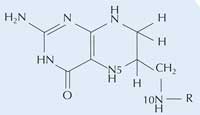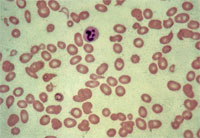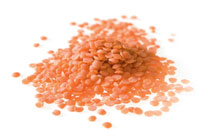Supporting materials
Download
Download this article as a PDF

Eleanor Hayes, Holger Maul and Nele Freerksen investigate why folic acid is an essential component of your students’ diet – now and for a future healthy family.
A tear rolled down Lucy’s cheek. “I never imagined anything could go wrong. I thought I’d stop taking the Pill, get pregnant, and have a healthy baby. And it all seemed to be working according to plan: I quickly got pregnant. When I went to the doctor, I thought he was over-reacting when he gave me some dietary tips, and told me to take folic acid supplements. I took the tablets, but asked myself ‘What could possibly go wrong with my baby?’”
When she was 17 weeks pregnant, though, she was told that her baby had spina bifida: the spinal cord had not fully closed, leaving the nerves unprotected. Damage to the nerves meant that her child would be confined to a wheelchair, incontinent, and have severe learning difficulties. After several weeks, much consultation and much thought, Lucy and her boyfriend took the agonising decision to terminate the pregnancy. A year later, she is still convinced that they made the right decision for their child, but the pain remains.

The tragedy of Lucy’s story is that it could probably have been avoided if she had taken the supplements earlier. Worryingly few young people, however, seem to know how essential folic acid is – or that it is important to take the supplement for at least a month before a pregnancy.
Each year, more than 4500 pregnancies in the European Union are affected by spina bifida and related disorders, known collectively as neural tube defects (Busby et al. 2005). In the UK, approximately 85% of pregnancies are terminated after the diagnosis, and around 150 people per year are born severely disabled by the spina bifidaw1.
It is estimated that in 75% of cases, spina bifida could have been prevented if the mother had taken folic acid supplements at the correct dose and early enough. A European study showed that in all 18 countries considered, only a minority of women took folic acid supplements before conceiving. The highest percentages of women taking folic acid before a pregnancy were found in the Netherlands, the UK, Ireland and Norway: 30-46%. In France, Spain, Germany and Italy, the percentages were much lower, at less than 5% (Eurocat Folic Acid Working Group, 2005).
Folic acid could have prevented 75% of spina bifida cases. However, in the remaining 25% of affected pregnancies, the situation is more complex: the risk of spina bifida is higher among women who have a family history of neural tube defects, have diabetes or are overweight. Spina bifida is also associated with certain medicines, for example some drugs that are used in chemotherapy or prescribed for certain autoimmune diseases. However, some of these complications are also associated with folic acid deficiency: some genetic mutations reduce the ability to metabolise folic acid, as do some drugs (e.g. methotrexate, used to treat rheumatoid arthritis and some cancers).
Folic acid is a water-soluble B vitamin, also known as vitamin B9. Folic acid or its naturally occurring form, folate, are essential for numerous physiological processes. Thus, both children and adults require a certain amount of folic acid; lack of folic acid can cause anaemia and severe birth defects. (We use the term ‘folate’ for the forms found in the body and ‘folic acid’ for the more stable form found in supplements.)


High levels of folate are found in fruit and vegetables, particularly leafy vegetables (such as spinach and lettuce), as well as in lentils, peas, and baker’s yeastw2. Humans are not capable of synthesising folate in the body, which means that they depend on sufficient levels of it in their diet. Although folate deficiency can have a number of biological causes – which reduce the ability of the body to absorb folate – the most common cause is simply that they eat too little folate (or folic acid).
In the body, folate is reduced to tetrahydrofolate, the biologically active form of folic acid. Tetrahydrofolate and its derivatives are essential co-enzymes in various carbon transfer reactions, receiving and accepting one-carbon units such as the methyl group (CH3).
A series of biochemical reactions use tetrahydrofolate to form methyl-tetrahydrofolate, an essential substrate in nucleotide synthesis. For example, together with vitamin B12, methyl-tetrahydrofolate is necessary for the formation of the pyrimidine base thymine (in DNA) as well as the purine bases adenine and guanine (in both DNA and RNA).
Tetrahydrofolate is also essential for the synthesis of several important amino acids. For example, it is a co-enzyme in the methylation of homocysteine to methionine, an amino acid required in numerous biochemical reactions such as the methylation of DNA and RNA.
A sufficient supply of folate is therefore required for both DNA and RNA synthesis and, as a result, for cell formation and regeneration. This is particularly important for all kinds of cells that undergo rapid division and growth – something that occurs especially during pregnancy and infancy, but also throughout life in the bone marrow. As cancerous tissues also undergo rapid cell division, this can be exploited: some drugs used in chemotherapy (e.g. methotrexate) actually target folate metabolism, limiting the growth rate of the tumour.
During the first three months of pregnancy, a lack of folic acid may lead to malformation of the embryo’s central nervous system – this results in neural tube defects such as spina bifida, or malformations of the brain or skull. A dietary intake of 400 µg folic acid per day has been shown to reduce neural tube defects in the embryo by up to 70%. Other studies have shown that folic acid supplements are also important for other developing organs in the embryo, reducing the risk of heart and limb defects or a cleft palate.
For these reasons, folic acid supplementation during pregnancy has become standard in many countries; in Germany and some other countries, women are also advised to take folic acid when they are planning to become pregnant. At present, the internationally recommended daily supplementation of folic acid for pregnant women or those who plan to conceive is 400 µg per day. Various research groups suggest that men who are planning to father a child should also increase their daily folic acid intake, because this has been shown to reduce the incidence of chromosomal defects in sperm.

Another manifestation of folic acid deficiency is megaloblastic anaemia – which can affect people of all ages, both male and female. A lack of folic acid slows down the rate of cell division in the bone marrow, resulting in the production of fewer but larger, immature red blood cells (erythrocytes). These abnormal erythrocytes are less able to carry oxygen to the tissues, and the sufferer will feel tired, weak and short of breath. Other effects include paleness and gastrointestinal symptoms such as gastric ulcers. Anaemia caused by folic acid deficiency can be treated with folic acid supplements; as the average life of a red blood cell is 40 days and all of them need to be replaced, though, it will take approximately 120 days for the treatment to be fully effective.
Vitamin B12 deficiency has very similar symptoms due to the interdependence of folic acid and vitamin B12 in DNA synthesis, but – unlike anaemia caused by folic acid deficiency – is also associated with neurological problems, which may be irreversible. Clearly, to treat the anaemia correctly, it is necessary to know which deficiency is causing the condition. In the early stages (before the neurological problems appear), the two types of deficiency can be distinguished by examining the blood levels of the two vitamins.
A further potential result of folic acid deficiency is the accumulation of homocysteine (normally methylised to methionine by tetrahydrofolate). Elevated levels of this sulphur-containing amino acid in the blood have been associated with an increased risk of cardiovascular disease.

Folic acid, therefore, is an important topic for school students to learn about – not only to ensure they are healthy now, but also to avoid problems in the future. To help our readers introduce the topic into their classroom and to motivate the students, Science in School has teamed up with a group of researchers at the medical faculty of the Otto von Guericke University in Magdeburg, Germany. In 2004, Dr Simone Pötzsch and her research group surveyed students at schools in one region of Germany to see how much they knew about the importance of vitamins and minerals – in particular folic acid (Pötzsch et al., 2006).
For Science in School, we have translated and adapted this survey so that teachers can assess their students’ knowledge – perhaps before introducing this article in a lesson. Teachers should exercise sensitivity when deciding whether to use the questionnaire, and if so, with which students. We also recommend asking the students’ parents for permission before using the survey, explaining that the data will be used in a European-wide survey.
The survey can be downloaded from the Science in School websitew3 or completed onlinew4. We will pass onto Dr Pötzsch all results that we receive by 31 December 2010. If enough schools take part, she and her group will use the data for a further European-wide study. The results will also be published in Science in School.
All surveys completed online will be automatically included. All printed surveys should be returned (by post or email) to:
Dr Eleanor Hayes
Editor-in-Chief of Science in School
European Molecular Biology Laboratory
Meyerhofstrasse 1
69117 Heidelberg
Germany
Email: editor@scienceinschool.org
The authors would like to thank Friedlinde Krotscheck for her help in planning the article and finding useful resources.
Very few biology textbooks stress the importance of folate in foetal development or in any other context. This article is overdue as an enrichment to the existing biology curricula, as it can be used as an excellent example when reviewing all of the main topics in human biology (see diagram). The metabolism of folate can be used to connect the major metabolic pathways while giving students a very useful understanding of their own body. For example, it could be employed in lessons to address an important principle in biology: the chain reactions in human metabolism that occur if one vitamin is in low supply.
Suitable comprehension questions include:
Discussion topics that could emerge from the article include family planning, lifestyle, government-prescribed nutrients in processed food, as well as the life-threatening conditions caused by folate deficiency. The positive message is that knowing and providing the right nutrients can eliminate or alleviate syndromes and metabolic diseases.
The accompanying questionnaire makes it possible for students to participate in ongoing research: taking part in data collection, the everyday work of the scientist. Seriously applied and truthfully answered, the questionnaire can be used to motivate a science class.
Students should learn about this topic even before puberty to understand the importance of a healthy lifestyle and then be reminded again and again as they grow older: folic acid – are you getting enough of it?
Friedlinde Krotschek, Germany
Download this article as a PDF